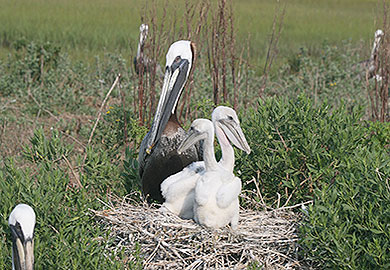DNR News
** Archived Article - please check for current information. **
October 17, 20142014 seabird nesting season sees return of pelicans to Bird Key
The seabird nesting season has come to an end and it was successful statewide. Colonial seabirds including Brown Pelicans, Royal Terns, Sandwich Terns, and Black Skimmers nested on S.C. Department of Natural Resources (DNR) Seabird Sanctuary islands located along the coast. Deveaux Bank, Bird Key and Crab Bank Seabird Sanctuaries provide ideal nesting and foraging conditions for these birds which make their nests on the ground and feed their chicks small fish.
Due to the sensitive nature of the colonies, portions of Deveaux Bank and all of Bird Key and Crab Bank are closed to the public from March 15 through Oct. 15 to protect breeding bird nests and their young. The beaches are now open until next spring. Dogs and camping are prohibited year round on these DNR managed islands.
DNR biologists survey seabird nests every summer on the DNR Seabird Sanctuaries and on federal and private islands to determine nesting trends of these colonial birds on each island and statewide. This season, biologists counted 4,701 Brown Pelican, 7,808 Royal Tern, 2,812 Sandwich Tern nests, and 800 Black Skimmer nests in South Carolina. "This year was very productive for many seabird species" said DNR Biologist, Janet Thibault. "The shorelines of these islands were full of adult terns feeding their young, and fledgling pelicans flapping their wings learning to fly." Black Skimmers, which have had several years of low nesting success, had over 100 chicks fledge from Deveaux Bank this year, a welcome sight.
and statewide. This season, biologists counted 4,701 Brown Pelican, 7,808 Royal Tern, 2,812 Sandwich Tern nests, and 800 Black Skimmer nests in South Carolina. "This year was very productive for many seabird species" said DNR Biologist, Janet Thibault. "The shorelines of these islands were full of adult terns feeding their young, and fledgling pelicans flapping their wings learning to fly." Black Skimmers, which have had several years of low nesting success, had over 100 chicks fledge from Deveaux Bank this year, a welcome sight.
2014 was especially exciting because of the return of nesting Brown Pelicans and Royal and Sandwich Terns to Bird Key Seabird Sanctuary. Bird Key, just off of Folly Beach in Charleston county, used to be the largest pelican nesting colony in the Southeast. The last year pelicans nested on the island was in 2004. This year there were over 200 pairs of nesting pelicans. "Providing and protecting nesting habitat for these beach nesting birds is important. It is great to see them back at Bird Key". said Wildlife Biologist Felicia Sanders.
All of these colonial seabirds, are listed as Highest Priority Conservation Status under the South Carolina Comprehensive Wildlife Conservation Strategy. For more information, check the DNR comprehensive conservation wildlife strategy webpage.
For additional information, contact Felicia Sanders at SandersF@dnr.sc.gov.
More News
- Venison is not only source of toxoplasmosis parasite
- 2014 seabird nesting season sees return of pelicans to Bird Key
- DNR to offer youth deer clinic in Edgefield on Nov. 4
- DNR to host series of family fishing clinics around the Midlands
- DNR officer recognized as QDMA 2014 Wildlife Officer of the Year
- Wild turkey harvest in SC decreases this spring
- Hunters must check deer taken on lower state WMAs
- Shooting sports offered to interested SC schools
- Preserve fall, winter habitat for quail, rabbits
- Waterfowl hunt application process is now open
- Wood duck box applications available until Nov. 1
- Numerous Hunter Education classes added to the Upstate
- Freshwater fishing trends
- Saltwater fishing trends
- S.C. weekly tidetable
- DNR video
- Archived news releases
